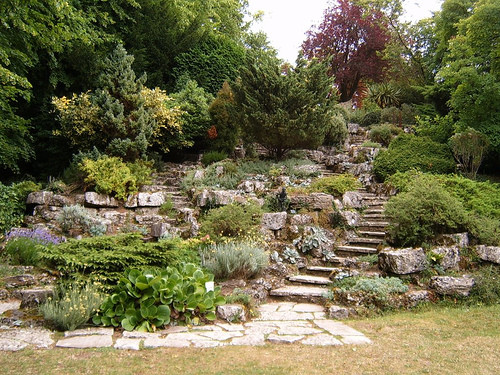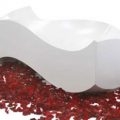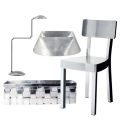 Rockary with their own hands
Rockary with their own hands First of all, you need to prepare the site.It's all done very simply. Choose a place that you usually don't have time for - an inconvenience, a place near a wall (but not under a drainpipe), near a fence or even right under the trees. Depending on the lighting, of course, the selection of plants changes, but the rockery will not lose out. If there are a lot of weeds in this place, such as bindweed, couch grass or thistle, cover the ground with a sheet of plywood, hardboard, black polyethylene or some other light- and moisture-proof material in early spring. By autumn, only a memory will remain of the weeds. At the end of summer, pour a pile of soil on the chosen site if you plan to make an alpine slide. No need to be clever with fertilizers, peat or compost: organic matter has too much effect on plant growth, and they stretch out too much - you have to either trim or pull them out. In addition, a lot of worms appear, which make passages, burrows under the stones, and they settle. We choose a viewing point for the future rock garden. Usually such a point is a bench or other place to rest. And when laying stones, we look at our work from there from time to time. It is best to lay small flat stones at the foot. We tamp the earth under them. Sunflower hill, especially large ones, can be laid with a foundation of "substandard" stones or brick fragments. You should not pile stones on top of each other, you definitely need free spaces. It is better to lay stones with the wide side down, while it is desirable that the top is flat.
First of all, you need to prepare the site.It's all done very simply. Choose a place that you usually don't have time for - an inconvenience, a place near a wall (but not under a drainpipe), near a fence or even right under the trees. Depending on the lighting, of course, the selection of plants changes, but the rockery will not lose out. If there are a lot of weeds in this place, such as bindweed, couch grass or thistle, cover the ground with a sheet of plywood, hardboard, black polyethylene or some other light- and moisture-proof material in early spring. By autumn, only a memory will remain of the weeds. At the end of summer, pour a pile of soil on the chosen site if you plan to make an alpine slide. No need to be clever with fertilizers, peat or compost: organic matter has too much effect on plant growth, and they stretch out too much - you have to either trim or pull them out. In addition, a lot of worms appear, which make passages, burrows under the stones, and they settle. We choose a viewing point for the future rock garden. Usually such a point is a bench or other place to rest. And when laying stones, we look at our work from there from time to time. It is best to lay small flat stones at the foot. We tamp the earth under them. Sunflower hill, especially large ones, can be laid with a foundation of "substandard" stones or brick fragments. You should not pile stones on top of each other, you definitely need free spaces. It is better to lay stones with the wide side down, while it is desirable that the top is flat. It is best to choose stones of the same color, ideally– of the same structure. They should be placed along the slope so that water does not stagnate - this causes some rocks to crack or peel. Leave enough free soil for plants to live, for example, for primrose - at least 10 cm2. After laying the stones, wash them with a brush, water the hill generously and leave everything until spring. By that time, the earth will settle and all the shortcomings and miscalculations will be more visible. In the spring, lift the stones, add soil where necessary and start planting plants. They should not obscure each other and cover the stones. It is better to choose plants for rock gardens either evergreen or with a very extended growing season. Various sedums, creeping thyme and subulate phlox look very good in the foreground. You can plant phlox with larger leaves, alpine rock cress or iberis behind them. Stachys lanata, primroses, perennial carnations and onions (chives, slime, narcissus-leaved) look magnificent. Tiny bells, heucheras and transparent pinkish-white clouds of gypsophila inflorescences look especially beautiful against the background of onions. Compact bushes of thin-leaved peony with decorative greenery of leaves are good, although it does not bloom for long. And Daurian lily is even more magnificent with clumps of cereals. By the way, about cereals. For a slide, choose those that do not form long underground rhizomes and grow compactly. For example, quaking grass, hedgehog, silver and long-haired feather grass, maned barley and some others. It should be said that cereals and plants with long or large leaves should be placed behind the stones, in the background. Do not forget about small shrubs such as Kuril tea or Cossack juniper.
It is best to choose stones of the same color, ideally– of the same structure. They should be placed along the slope so that water does not stagnate - this causes some rocks to crack or peel. Leave enough free soil for plants to live, for example, for primrose - at least 10 cm2. After laying the stones, wash them with a brush, water the hill generously and leave everything until spring. By that time, the earth will settle and all the shortcomings and miscalculations will be more visible. In the spring, lift the stones, add soil where necessary and start planting plants. They should not obscure each other and cover the stones. It is better to choose plants for rock gardens either evergreen or with a very extended growing season. Various sedums, creeping thyme and subulate phlox look very good in the foreground. You can plant phlox with larger leaves, alpine rock cress or iberis behind them. Stachys lanata, primroses, perennial carnations and onions (chives, slime, narcissus-leaved) look magnificent. Tiny bells, heucheras and transparent pinkish-white clouds of gypsophila inflorescences look especially beautiful against the background of onions. Compact bushes of thin-leaved peony with decorative greenery of leaves are good, although it does not bloom for long. And Daurian lily is even more magnificent with clumps of cereals. By the way, about cereals. For a slide, choose those that do not form long underground rhizomes and grow compactly. For example, quaking grass, hedgehog, silver and long-haired feather grass, maned barley and some others. It should be said that cereals and plants with long or large leaves should be placed behind the stones, in the background. Do not forget about small shrubs such as Kuril tea or Cossack juniper. A few words about bulbous plants.These plants have a short growing season, so it is better to plant them on the border with stones or on areas covered with moss. Of the bulbous plants, pushkinia, snowdrops, scilla and even tulips look good on the hill. But low-growing tulips are chosen for the alpine hill, and ideally - wild plants. They do not freeze, do not need annual digging, if the distance between plants is sufficient - 25-30 cm. After flowering perennials, it is better to remove faded inflorescences, otherwise there will be a scattering of seeds and the "neighbors" will mix up all your clumps, and the flower bed will no longer look the same. In the fall, the entire hill must be properly weeded, and in the winter, covered with snow. In the spring, raise the stones again, add soil. And in the summer you can already admire your work to your heart's content. A little about the "shade" rockery. The principles of its construction are the same, only the plants change. In a "shady" rock garden, loosestrife is good to plant in the foreground, with European asarum and liverwort above. Saxifraga umbrosa feels good in the shade. A fern will be a real decoration of such a hill, but its fronds (leaves) unfold only in May, so early plants such as anemones (buttercup and oak wood anemones), and corydalis can be planted around it. Of course, flowers of globeflowers (European and Asian) will also decorate the hill. The pleasure of contemplating a "shady" hill is no less than from a "sunny" one. The following article presents
A few words about bulbous plants.These plants have a short growing season, so it is better to plant them on the border with stones or on areas covered with moss. Of the bulbous plants, pushkinia, snowdrops, scilla and even tulips look good on the hill. But low-growing tulips are chosen for the alpine hill, and ideally - wild plants. They do not freeze, do not need annual digging, if the distance between plants is sufficient - 25-30 cm. After flowering perennials, it is better to remove faded inflorescences, otherwise there will be a scattering of seeds and the "neighbors" will mix up all your clumps, and the flower bed will no longer look the same. In the fall, the entire hill must be properly weeded, and in the winter, covered with snow. In the spring, raise the stones again, add soil. And in the summer you can already admire your work to your heart's content. A little about the "shade" rockery. The principles of its construction are the same, only the plants change. In a "shady" rock garden, loosestrife is good to plant in the foreground, with European asarum and liverwort above. Saxifraga umbrosa feels good in the shade. A fern will be a real decoration of such a hill, but its fronds (leaves) unfold only in May, so early plants such as anemones (buttercup and oak wood anemones), and corydalis can be planted around it. Of course, flowers of globeflowers (European and Asian) will also decorate the hill. The pleasure of contemplating a "shady" hill is no less than from a "sunny" one. The following article presents

Making Money with Desserts: Success Stories
Evgeniya Polischuk (Fedutinova) instagram:@evgeniyafedutinovavk.com/janeshomebaking– It all started with baking for family and friends. Gradually, I started posting photos of my baked goods on Instagram – and orders started coming in. I made my first custom-made cake on October 13, 2014, and a little earlier I started making macaroons and cupcakes. You could say that the business “found me”, I am very […]

Soups are cold recipes with photos
Cold cucumber soup with yogurt and lemonsorbet from the chef of the restaurant La Taverna Alexander Zhurkin Photo: Getty Images Ingredients: Plain yoghurt – 125 g Cucumber – 150 g Lemon/lime sorbet – 50 g Cocktail shrimp – 24 g Fresh ginger juice – 1 g Lime juice – 5 g Fresh orange juice – 5 g Parsley – 1 g Pink pepper – 1 g Watercress – […]

barbeque kebab
Pork tenderloin in glaze Photo:Dmitry Bayrak/dbstudioPreparation time: 20 minutes + marinating time.Calories: 454 kcal per serving.For 4 servings: 4 pork tenderloins (approximately 300 g each), 1 onion, 2 cloves of garlic, 1 tsp. lemon zest, 1 tsp. lemon juice, a pinch of ground cumin, coriander and turmeric, 1 tbsp. vegetable […]

Pierre Duacan: dietary recipes: Ducane diet
Beetroot soup Photo:Season’S, Luxury Hotels RepresentationYou will need:· Boiled beetroot – 60 g· Fresh cucumbers – 20 g· Red radish – 20 g· Green onions – 10 g· Egg – 1 pc.· Drinking mineral water – 200 g· Salt – 1 gPreparation:· Boil the egg and beetroot.· Grate the cucumbers, radish and part of the beetroot. Put everything […]





